Land Clearing With Your Tractor
TBN | Posted on |
Land Clearing Basics
Have some land or a field that needs clearing? Well join the club. TractorByNet members have cleared thousands of fields and plots of land and with that comes a lot of experience on what to do (and not do). In this article we’ve pulled together some useful tips and tricks for land clearing for tractor owners.
Before you take action…
Before you get started, remember the old saying measure once, cut twice? Or is it measure twice, cut once? Maybe it’s measure three times, cut twice? Ah, who knows. Let’s just say that as tempting as it may be to just start knocking trees down, it’s a better idea to take a step back and plan before you hit the ground with your equipment. Part of that process is consulting all parties involved in the project and making sure you know what you want the end result to be before you set off on a tractor rampage.
- Why am I clearing this field?
- What lies beneath (or above)? Utilities? Septic? Natural spring?
- Will I be shaping the land or just clearing the surface?
- What should my finished result look like?
- What tools will I need to get the job done?
- Who will do the work?
- What’s my budget?
- When do I need the job done?
Land clearing can be a job that takes a few hours with one tool, or a multi-day job with tree removal, rock removal, shrub cutting, etc.
[spacer style=”1″]
Field Clearing or Land Clearing?
You may have seen the terms field clearing and land clearing thrown around without explanation. To summarize, the terms are largely interchangeable with the term land clearing applying to clearing any plot of land for any reason (say, for a road or pond) versus the term field clearing just indicating that the cleared land will be turned into a field or open area. Technically field clearing involves land clearing so you can’t get to one without the other.
[spacer style=”1″]
Land Clearing, Step By Step
The usual process of land or field clearing can be broken down into the following steps:
-
The before picture — make sure you document your hard work!
-
Rough cut – Remove all unwanted trees and brush, stumps, large stones, garbage, etc.
-
Land shaping – Adding or subtracting earth based on your plan.
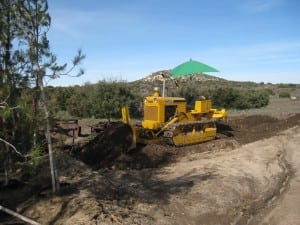
You might need the services of a bulldozer if your plans include extensive earth moving. Photo by MtnViewRanch. -
Finishing – Final grading and raking to remove stones and small debris.
-
Seeding – The final step of finish work. Next step is waiting for the grass to grow.
[spacer style=”1″]
Common Land Clearing Tools (Depending on the job size)
Once you’ve decided that you’re going to tackle a land clearing project, you can assemble your arsenal of tools (hopefully you’ve already got most of these, or else a shopping/rental trip might be in order):
[row][double_paragraph]
Chainsaw
For cutting trees and thick shrubs that your tractor/equipment would be unable to safely fell. Keep in mind that stumps will remain and need to be dug out or ground down if you need a clean layer of topsoil.[/double_paragraph][double_paragraph]  [/double_paragraph] [/row]
[/double_paragraph] [/row]
[row][double_paragraph]
Bulldozer
Whoa, that escalated quickly! The dozer is a classic land and field clearing machine that comes in many sizes. Most TractorByNet members agree that for land clearing, a small dozer will be limited in terms of what it can do, and might not be the right choice if you have a big area to clear or a bunch of stumps to remove. Using a dozer will mean your finished field will be rough, but clear of the big stuff that you didn’t want to take out with your tractor. You’re likely going to have a pile of tree parts, debris, rocks, and dirt at the end of the dozer stage. For reference, this John Deere 650J LGP dozer is around 20,000lbs. [/double_paragraph]
[double_paragraph]  [/double_paragraph] [/row]
[/double_paragraph] [/row]
[row][double_paragraph]
Mulcher
A mulcher (or subsoiler) is a pro’s tool that will chop and destroy almost any ground cover your field can throw at it. The smaller units can run on 50+ horsepower tractors on the 3-point hitch and PTO, but it’s common to see them mounted on skid-loaders. Renting or hiring a professional with one of these is one way to make quick work of field clearing jobs. The advantage is you can dig down and pulverize roots with a mulcher.
[/double_paragraph]
[double_paragraph]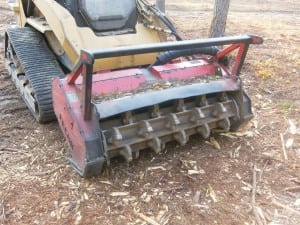 [/double_paragraph] [/row]
[/double_paragraph] [/row]
[row][double_paragraph]
Stump Grinder
if you have a limited number of stumps and are satisfied with just grinding them down, the stump grinder might be all you need.
[/double_paragraph][double_paragraph]  [/double_paragraph] [/row]
[/double_paragraph] [/row]
[row][double_paragraph]
Backhoe or Excavator
For digging out stumps, digging trenches, culverts, or holes. Can also be used to dig around large, embedded objects like big rocks. Larger excavators (most recommend 18k lbs for a land clearing project) can be used like a dozer, and the boom can be used to push trees down away from you. Excavators can also be equipped with mulchers, grinders, and grapple buckets to take care of a variety of tasks. [/double_paragraph][double_paragraph] [/double_paragraph] [/row]
[/double_paragraph] [/row]
[row][double_paragraph]
Front Loader
It might sound crazy, but a front loader is probably not the most efficient tool for land clearing. The strength of a dozer will make quick work of ripping and pushing where a front-end loader will take longer to do the same tasks. But, it’s still going to be necessary at some point in the job (cleanup crew). [/double_paragraph][double_paragraph]  [/double_paragraph] [/row]
[/double_paragraph] [/row]
[row][double_paragraph]
Rotary Cutter
Great for field clearing jobs that have hay, grass, and shrubs less than the thickness your rotary cutter is rated for. For smaller compact tractors under 50 horsepower, that’s usually a 1″ diameter rating, but utility tractors can usually handle rotary cutters that can chop up to 2″. Keep in mind that a cluster of 1″ brush stems is going to bog you down if you try to take it all at once. Keep in mind your tractor’s capacity to actually handle what you throw at it.
[/double_paragraph][double_paragraph] 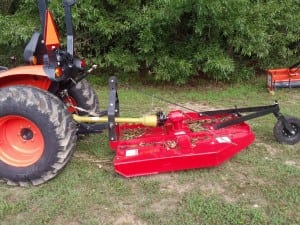 [/double_paragraph] [/row]
[/double_paragraph] [/row]
[row][double_paragraph]
Box Scraper (aka Box Blade)
Great for for scraping and filling dirt. The teeth come in handy for ripping roots, too.
[/double_paragraph][double_paragraph]  [/double_paragraph] [/row]
[/double_paragraph] [/row]
[row][double_paragraph]
Blade
A 3-point hitch mounted blade is very versatile for land clearing. You can push, pull, dig, cut trenches, and even get a pretty decent finish layer if you’re good with the blade. Might be a tough choice to mount the box scraper or rear blade for the majority of your clearing work, but it will depend on how uneven the land is.
[/double_paragraph][double_paragraph] 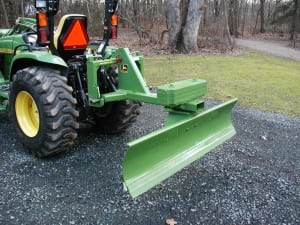 [/double_paragraph] [/row]
[/double_paragraph] [/row]
[row][double_paragraph]
Field Cultivator
A field cultivator can penetrate 6-12″ depending on the conditions and help clear some of that ground cover, roots, and messy stuff that the rotary cutter doesn’t get to, and the loader take a long time with.[/double_paragraph][double_paragraph] [/double_paragraph] [/row]
[/double_paragraph] [/row]
[row][double_paragraph]
Disc
A simple 3-point disc is a great choice for after land shaping is done. It will break up hard, compacted soil and get it ready for planting.
[/double_paragraph][double_paragraph]  [/double_paragraph] [/row]
[/double_paragraph] [/row]
[row][double_paragraph]
Landscape Rake
A multi-use tool when it comes to land clearing. Some use the rake for gathering up brush and debris in very light land clearing jobs. Also great for raking rocks and debris off a dirt surface. Good for when you’re at or near the end of your project. They make power rakes, too, but they’re expensive (and awesome).
[/double_paragraph][double_paragraph]  [/double_paragraph] [/row]
[/double_paragraph] [/row]
[row][double_paragraph]
Bucket Teeth (Tooth bar)
Great inexpensive add-on for getting some cutting action with your FEL bucket.
[/double_paragraph][double_paragraph]  [/double_paragraph] [/row]
[/double_paragraph] [/row]
[row][double_paragraph]
Bucket Rake
Ratchet Rake makes a good quality ratchet-on rake for the FEL bucket. Great for land clearing jobs.
[/double_paragraph][double_paragraph]  [/double_paragraph] [/row]
[/double_paragraph] [/row]
[row][double_paragraph]
4-in-1 Bucket
A multi-purpose bucket attachments that turns the front-end loader into a bucket, grapple, blade, and clam shell—four uses in one.
[/double_paragraph][double_paragraph]  [/double_paragraph] [/row]
[/double_paragraph] [/row]
[row][double_paragraph]
Grapple Bucket
Great for grabbing brush and debris. A grapple bucket is the perfect tool for cleaning up a field.
[/double_paragraph][double_paragraph]  [/double_paragraph] [/row]
[/double_paragraph] [/row]
[row][double_paragraph]
Top-N-Tilt Kit (aka TNT)
Great for back-filling and grading, a TNT will allow you to angle and tilt your 3-point hitch blade, rake, or scraper to get better cutting, scraping, and filling abilities. This is on the wish list for most tractor owners, so maybe a clearing project is the perfect time for an upgrade?
[/double_paragraph][double_paragraph]  [/double_paragraph] [/row]
[/double_paragraph] [/row]
[spacer style=”1″]
Tips For Land Clearing
Safety First
Land clearing is one of the more dangerous jobs for a do-it-yourself-er. You’ve got falling trees, debris, heavy equipment, and a lot of variables. If it’s your first time (or a routine job for you), you’ll definitely want to have a safety plan in place for your project. That includes everything from equipment operation (read manuals), to communication (cell phone, walkie-talkie), to emergency action plans.
Renting equipment?
Consider renting some heavy duty tools to help with the project. A dozer, excavator, or mulcher can be a lot of help (or maybe even get the entire job done!).
Removing roots?
If you plan on planting a productive field after you’re done, you’ll need to remove roots. What that entails will depend on your situation. Possible more heavy equipment (see above re: calling in the pros or renting the pro equipment).
What to do with your debris pile at the end?
Mulch, bury, burn, or haul are usually the options. You can use it as fill elsewhere on your property. Mulching the wood is nice if you have a use for mulch. Burning will depend on your area—if it’s allowed (in most places you need a permit) and if you can manage a controlled fire with professional oversight. Hauling away might be costly if your debris isn’t good clean fill. Mulching the good stuff and using the rest for clean fill is a sensible solution.
What’s the best tool for the job?
Wish we could give one simple answer but it really does depend on the job. Having said that, a very common combination is a rented/hired dozer for rough cut, and then finishing the job with your tractor and attachments. Small land clearing finish jobs can be tackled by small tractors. If you’ve got a big plot, big trees, and big plans, you probably already have a utility-size tractor more appropriate for that size of job. In the end, it comes down to what will get the job done quickly (if you need that) versus inexpensively (if you need that).
Don’t forget about drainage.
While you’ve got all the equipment out, now’s the time to think about drainage, depending on the lot and your climate.
[spacer style=”1″]
More About Land Clearing
If you’d like to read more about land clearing topics, here are some popular discussions from our forums:
- The age old..”what’s the best land clearing technique” question again
- Clearing Recently Purchased Land
- Clearing stumps?
- Clearing/Grading ridge for road – best equipment?
- Clearing Brush- What do you use?
- New here – Clearing the pine trees on our land, is this contract fair?
- Homemade Hydrolic Brush Cutter/ Land Clearing attachment for Bobcat
- Opinions from land clearing experts please?
- How to tackle this new project. Clearing land. Any opinions???
- Clearing Land
- Land Clearing ~ 30 acres
- Clearing Land. Near the end but too much labor needed. Suggestions– pic included
- New land owner, clearing land help
- Clearing Old Cutover / 150 acres
- Newbie here! Just closed on 80 acres. Question about land clearing…




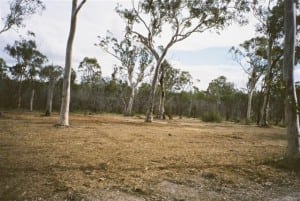
6 Comments
Great job Muhammed, well researched and articulated. This should be a big help to the uninitiated. As a lot f TBNers live in semi rural areas one big thing to add: “Check local ordinances for restrictions and permit requirements especially for burning if that is anticipated”
Where I lived on 21Ac you even need a county hydraulic permit to build a bridge or place a culvert; even the local Indian tribe has a say in the matter. If your property is urban zoned you need a permit to take down a tree. Removing acers of trees requires a state logging permit. An environmental permit is required to clear an area prior to getting a building permit, On and on it goes, we no longer own our destiny when buying land. my county continuously over flies and maps to detect improvements done w/o permits and then takes legal action, gets spendy when they catch you.
Great message that even semi-experienced owners can benefit from viewing. Probably the best I have seen.
You left out the most important tool in our land clearing process, a pto self feeding chipper. I could not have done what I did without our woodmax chipper(s)
Started off with their
http://www.woodmaxx.com/WM_8M_Mechanical_PTO_Wood_Chipper_p/wm-8m.htm
then sold it when most of the clearing was done and bought their
http://www.woodmaxx.com/TM_86H_PTO_Wood_Chipper_p/tm-86h.htm
which is lighter and much easier to manage
I don’t know how you can have an article on this subject without mentioning a flail mower… especially when you mention a rotary cutter.
Found the 2-ton winch and the wood chipper for the tractor very handy when I cleared the new lot I bought a few years ago. Lot of the brush wasn’t good for anything, and we had a fire ban.
Thanks for explaining that a 4-in-1 bucket can be used as a bucket or a blade. My dad is starting a farm next year, and he is looking for tools to use for his tractor. I’ll tell him about the versatility of 4-in-1 buckets and how they might be useful to him.